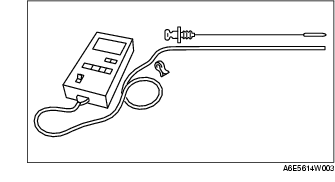AUTOMATIC TRANSAXLE FLUID (ATF) INSPECTION [JA5AX-EL]
AUTOMATIC TRANSAXLE FLUID (ATF) INSPECTION [JA5AX-EL]
id051705800500
Automatic Transaxle Fluid (ATF) Condition Inspection
1. One way of determining whether the transaxle should be replaced is by noting:
-
• If the ATF is muddy or varnished.
-
• If the ATF smells strange or unusual.
ATF Condition
|
Condition
|
Possible cause
|
|
Clear dark red
|
Normal
|
-
|
|
Light red (pink)
|
Contaminated with water
|
• Broken oil cooler inside of radiator
• Poor filler tube installation:
Problem could be occurring to parts inside the transaxle by water contamination. If necessary, exchange transaxle.
|
|
Reddish brown
|
Has burnt smell and metal specs are found
|
Deteriorated ATF
|
Defect powertrain components inside of transaxle:
Specks cause wide range of problems by plugging up in oil pipe, control valve body and oil cooler in radiator.
• When large amount of metal specks are found. Exchange transaxle if necessary.
• Implement flushing operation as there is a possibility to have specks plugging up oil pipe and/or oil cooler inside of radiator.
|
|
Has no burnt smell
|
Normal
|
• Discoloration by oxidation
|
Automatic Transaxle Fluid (ATF) Level Inspection
-
Caution
-
• The ATF amount varies according to ATF's temperature. Therefore, when checking the ATF level or replacing the ATF, use a thermometer to measure the temperature then adjust the ATF amount to the specified level according to the specified temperature.
1. Park the vehicle on level ground.
2. Apply the parking brake and position wheel chocks securely to prevent the vehicle from rolling.
3. Adjust the length of the thermistor probe measure to the measure same as the dipstick and hold the probe with a paper holder.
4. Insert into the filler tube and measure the temperature.
5. Warm up the engine until the ATF reaches (60-70 °C {140-158 °F}).
-
Caution
-
• Do not warm the transaxle by performing stalls. This will damage the torque converter.
-
Note
-
• In some cases it may be necessary to inspect the ATF in the cool range 15-25 °C {59-77 °F} before warming up the engine.
6. While depressing the brake pedal, shift the selector lever to each range (P-M), pausing momentarily in each range.
7. Shift back to P position.
-
Note
-
• If the ATF level is too high or too low in hot condition, the following problems may be the cause.
|
ATF level
|
Condition
|
Possible cause
|
|
Too low
|
Line pressure is lower than the specification
|
Air in transaxle oil passage due to slipping or damaged clutch mechanism
|
|
Too high
|
ATF is hot
|
ATF deteriorated due to slipping clutch or stuck valve
|
8. While the engine is idling, verify that the ATF level is in the HOT (65 °C {149 °F}) range. Add the ATF specified type of, if necessary. (See AUTOMATIC TRANSAXLE FLUID (ATF) REPLACEMENT [JA5AX-EL].)
ATF
-
Type: ATF M-III or equivalent (e.g. Dexron®III)
-
Capacity (Approximate quantity): 8.3 L {8.8 US qt, 7.3 Imp qt}
